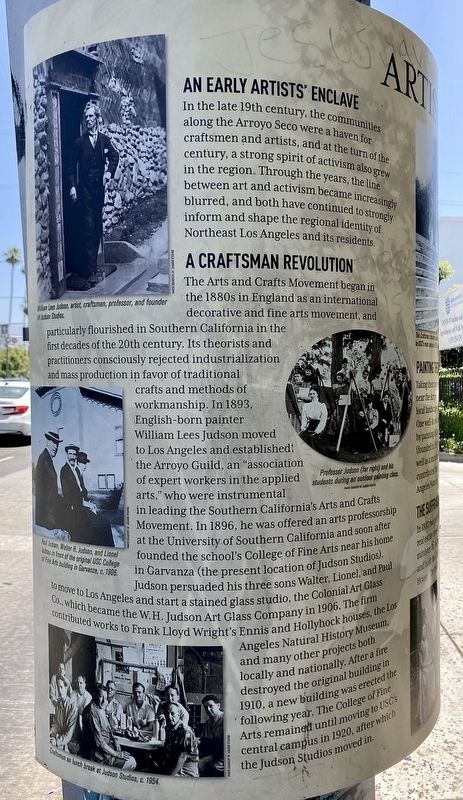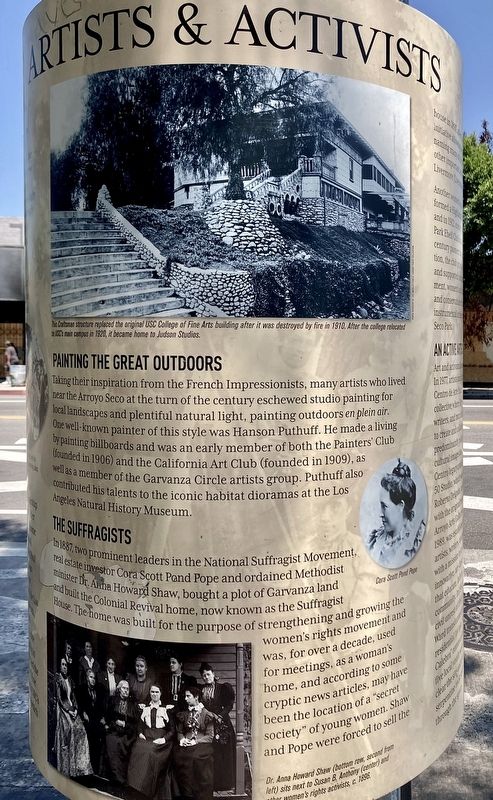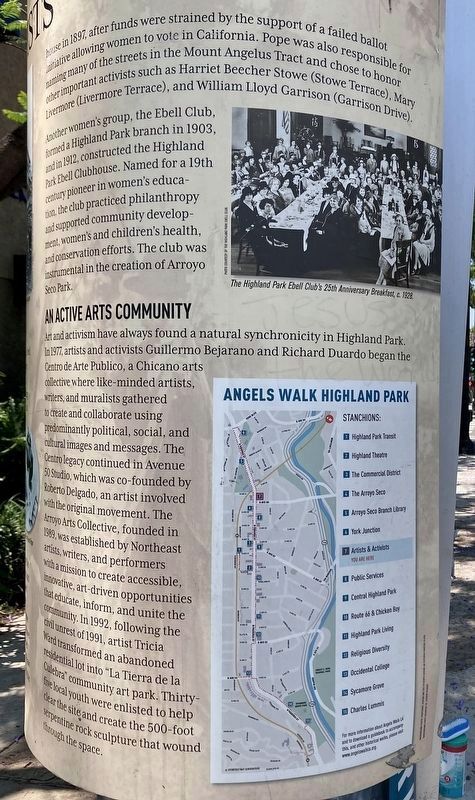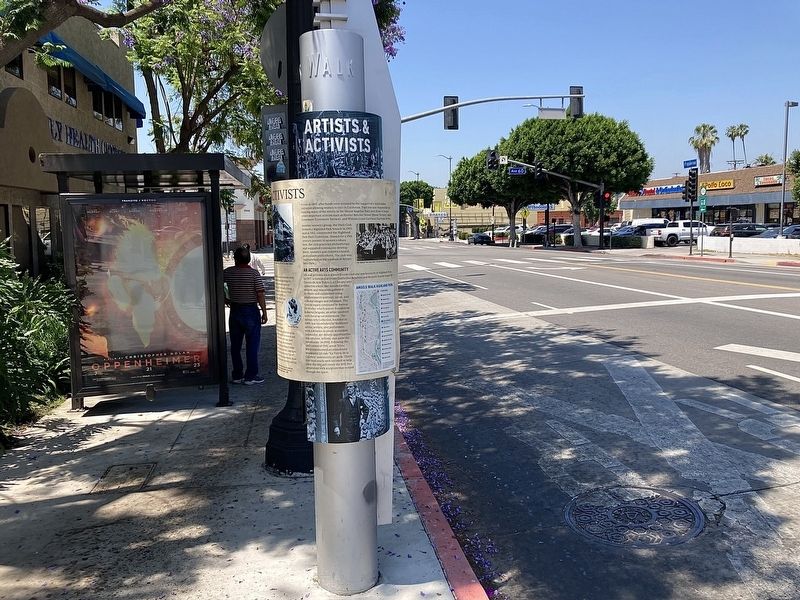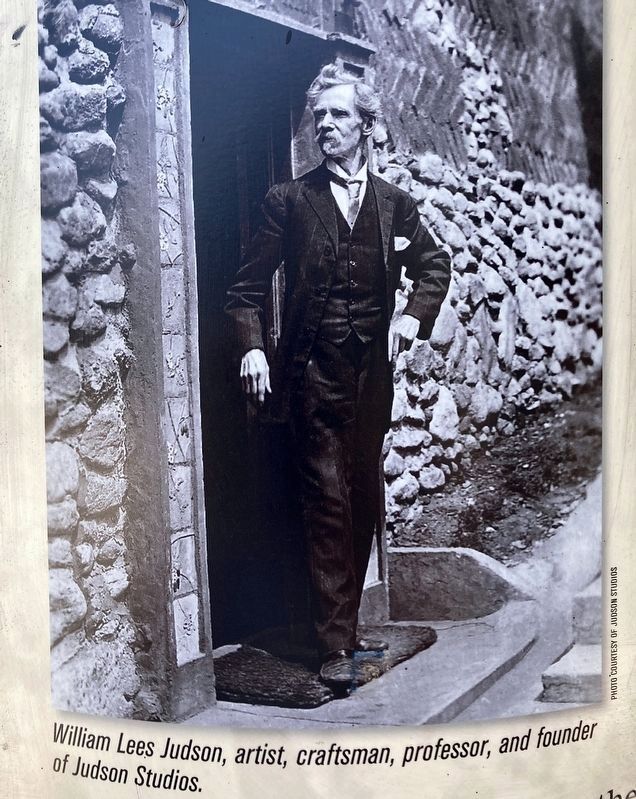Highland Park in Los Angeles in Los Angeles County, California — The American West (Pacific Coastal)
Artists & Activists
An Early Artists’ Enclave
In the late 19th century, the communities along the Arroyo Seco were a haven for craftsmen and artists, and at the turn of the century, a strong spirit of activism also grew in the region. Through the years, the line between art and activism became increasingly blurred, and both have continued to strongly inform and shape the regional identity of Northeast Los Angeles and its residents.
A Craftsman Revolution
The Arts and Crafts Movement began in the 1880s in England as an international decorative and fine arts movement, and particularly flourished in Southern California in the first decades of the 20th century. Its theorists and practitioners consciously rejected industrialization and mass production in favor of traditional crafts and methods of workmanship. In 1893, English-born painter William Lees Judson moved to Los Angeles and established the Arroyo Guild, an "association of expert workers in the applied arts," who were instrumental in leading the Southern California's Arts and Crafts Movement. In 1896, he was offered an arts professorship at the University of Southern California and soon after founded the school's College of Fine Arts near his home in Garvanza (the present location of Judson Studios). Judson persuaded his three sons Walter, Lionel, and Paul to move to Los Angeles and start a stained glass studio, the Colonial Art Glass Co, which became the W.H. Judson Art Glass Company in 1906. The firm contributed works to Frank Lloyd Wright's Ennis and Hollyhock houses, the Los Angeles Natural History Museum, and many other projects both locally and nationally. After a fire destroyed the original building in 1910, a new building was erected the following year. The College of Fine Arts remained until moving to USC’s central campus in 1920, after which the Judson Studios moved in.
Painting the Great Outdoors
Taking their inspiration from the French Impressionists, many artists who lived near the Arroyo Seco at the turn of the century eschewed studio painting for local landscapes and plentiful natural light, painting outdoors en plein air. One well-known painter of this style was Hanson Puthuff. He made a living by painting billboards and was an early member of both the Painters' Club (founded in 1906) and the California Art Club (founded in 1909), as well as a member of the Garvanza Circle artists group. Puthuff also contributed his talents to the iconic habitat dioramas at the Los Angeles Natural History Museum.
The Suffragists
In 1887, two prominent leaders in the National Suffragist Movement, real estate investor Cora Scott Pond Pope and ordained Methodist minister Dr. Anne Howard Shaw, bought a plot of Garvanza land and built the Colonial Revival home, now known as the Suffragist House. The home was built for the purpose of strengthening and growing the women's rights movement and was, for over a decade, used for meetings, as a woman's home, and according to some cryptic news articles, may have been the location of a "secret society" of young women. Shaw and Pope were forced to sell the house in 1897, after funds were strained by the support of a failed ballot initiative allowing women to vote in California. Pope was also responsible for naming many of the streets in the Mount Angelus Tract and chose to honor other important activists such as Harriet Beecher Stowe (Stowe Terrace), Mary Livermore (Livermore Terrace), and William Lloyd Garrison (Garrison Drive).
Another women's group, the Ebell Club, formed a Highland Park branch in 1903, and in 1912, constructed the Highland Park Ebell Clubhouse. Named for a 19th century ploneer in women's education, the club practiced philanthropy and supported community development, women's and children's health, and conservation efforts. The club was instrumental in the creation of Arroyo Seco Park.
An Active Arts Community
Art and activism have always found a natural synchronicity in Highland Park. In 1977, artists and activists Guillermo Bejarano and Richard Duardo began the Centro de Arte Publico, a Chicano arts collective where like-minded artists, writers, and muralists gathered to create and collaborate using predominantly political, social, and cultural images and messages. The Centro legacy continued in Avenue 50 Studio, which was co-founded by Roberto Delgado, an artist involved with the original movement. The Arroyo Arts Collective, founded in 1989, was established by Northeast artists, writers, and performers with a mission to create accessible, innovative, art-driven opportunities that educate, inform, and unite the community. In 1992, following the civil unrest of 1991, artist Tricia Ward transformed an abandoned residential lot into "La Tierra de la Culebra" community art park. Thirty-five local youth were enlisted to help clear the site and create the 500-foot serpentine rock sculpture that wound through the space.
Erected 2017 by City of Los Angeles.
Topics. This historical marker is listed in these topic lists: Arts, Letters, Music • Settlements & Settlers • Women. A significant historical year for this entry is 1893.
Location. 34° 6.69′ N, 118° 11.324′ W. Marker is in Los Angeles, California, in Los Angeles County. It is in Highland Park. Marker is at the intersection of Figueroa Street and Avenue 60, on the right when traveling north on Figueroa Street. Touch for map. Marker is at or near this postal address: 6000 N Figueroa St, Los Angeles CA 90042, United States of America. Touch for directions.
Other nearby markers. At least 8 other markers are within walking distance of this marker. The Arroyo Seco (about 300 feet away, measured in a direct line); Public Services (about 500 feet away); Drake House (about 700 feet away); G.W.E. Griffith House (about 700 feet away); Distribution Station No. 2 (approx. 0.2 miles away); Arroyo Seco Branch Library (approx. ¼ mile away); The Commercial District (approx. ¼ mile away); First Electric Power Pole (approx. ¼ mile away). Touch for a list and map of all markers in Los Angeles.
Also see . . . Angels Walk L.A. Self-guided walking tours of historic neighborhoods in Los Angeles. The Artists & Activists marker is part of the Highland Park walk. (Submitted on July 16, 2023.)
Credits. This page was last revised on July 16, 2023. It was originally submitted on July 16, 2023, by Craig Baker of Sylmar, California. This page has been viewed 79 times since then and 14 times this year. Photos: 1, 2, 3, 4, 5. submitted on July 16, 2023, by Craig Baker of Sylmar, California.
